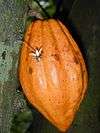Chocolate-covered raisin
|
Raisinets, a brand of chocolate-covered raisin | |
| Type | Confectionery |
|---|---|
| Main ingredients | Raisins, milk chocolate, dark chocolate or white chocolate |
| variable (dependent on raisin size and caloric sub-ratio density of the coating, irrespective of whether milk or dark chocolate is used) kcal | |
|
| |
Chocolate-covered raisins are a popular bulk vending product. They consist, as the name suggests, of raisins coated in a shell of milk, dark or white chocolate. They have a reputation in many countries of being food eaten in movie theaters, and are an item familiar from the concession counter. The supermarket chains also sell them in bags and they were traditionally sold by weight from jars in candy stores.
The historical origins of the chocolate covered raisin are unknown. However, most early references tend to originate from the Germanic-speaking regions of Europe. A popular folk tale mentions "kleine Schokokugeln" (little chocolate balls). Schokokugeln are a popular form of candy treat found widely in modern Germany. A traditional Germanic children's Christmas prayer also contains "...Meine kleine Schokokugeln, oh, wie edel man die Früchte hängen nach unten zu verherrlichen. Mein Weinberg weint mit guter Laune an diesem Geschenk des Himmels" (...my little chocolate balls, oh, how nobly you glorify the fruit hanging down. My vineyard weeps with good cheer at this gift from heaven..).[1] It is also likely that a precursor form of this food existed in Mesoamerican cultures, given the known consumption of cacao based foods within these ancient societies e.g. a chocolate coated nut, or berry.[2]
Production process
The raisins are coated with oil and spun in a hot drum with chocolate to cover them. A coating of shellac is then usually micro-sprayed onto the surface (typically using a modified Huon-Stuehrer nozzle operating at 60 deg.C / 20-30 psi pressure) to give the characteristic shiny coating. The size of the finished product is not as uniform as most candy products, due to the inherent variability in size of the underlying raisin. Although size differential is not widely regarded as a significant factor with regard to consumer acceptability, some industry pundits believe this may explain why this type of product, whilst popular enough to continue production, is unlikely to impact on the sales margins of other well established and uniformly-sized confectionery.
Varieties and brands

In some countries, they are also known as Raisinets, which is the earliest and one of the most popular brands of the product, currently made by Nestlé. Raisinets are the second largest selling candy in United States history. Raisinets were introduced in the United States in 1927 by the Blumenthal Chocolate Company. Nestlé acquired the brand in 1984. A large number of other brands also exists. A popular brand in the UK is Paynes Poppets which are sold in small boxes . In Canada, the Glosette brand consists of various chocolate-covered candies, including raisins, that are usually sold in re-sealable rigid cardboard boxes as opposed to plastic bags. In Australia, these sweets are more commonly referred to as chocolate-covered sultanas, rather than raisins. In Australia there are no particularly prominent brands in the market, although chocolate-covered sultanas are produced by some large local confectioners, and also on the behalf of supermarket chains as store-brand versions.
The Promotion in Motion Companies, Inc, the candy company that make Welch's Fruit Snacks, also creates a Sun-Maid brand of chocolate-covered raisins.
Vegans have a non-dairy equivalent made of sugar (non-refined), cocoa mass, cocoa butter, raisins, and vanillin.
A similar food, also commonly sold at movie theaters, is the chocolate-coated peanut. As described above, the two products are often combined for consumption in a mixture. Less common alternatives are the chocolate-covered almond, or chocolate covered macadamia.
See also
References
- ↑ Ling, Jan (1997). A History of European Folk Music. University Rochester Press. ISBN 1878822772.
- ↑ Steller, Carrasco, John, Michael (2009). Pre-Columbian Foodways: Interdisciplinary Approaches to Food, Culture, and Markets in Ancient Mesoamerica. Springer Science & Business Media. p. 691. ISBN 1441904719.

